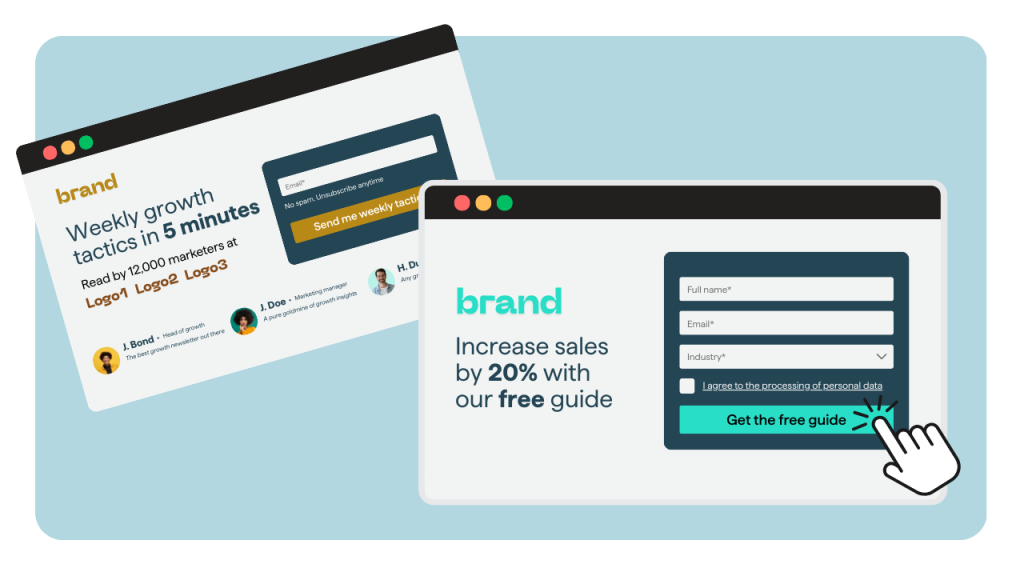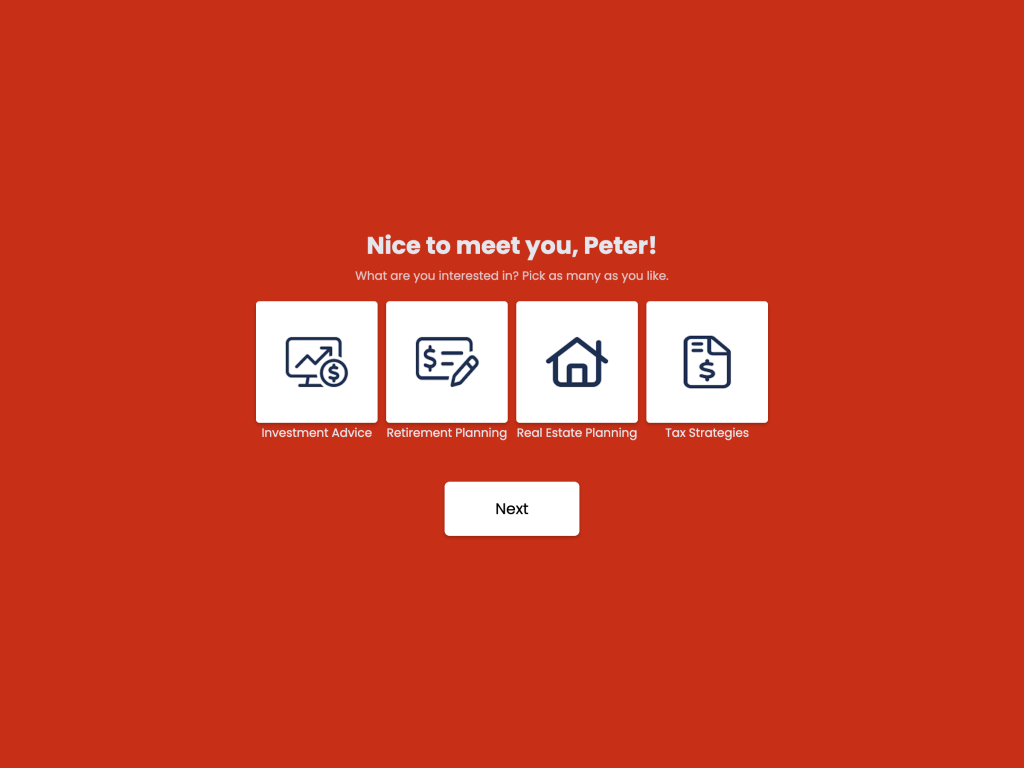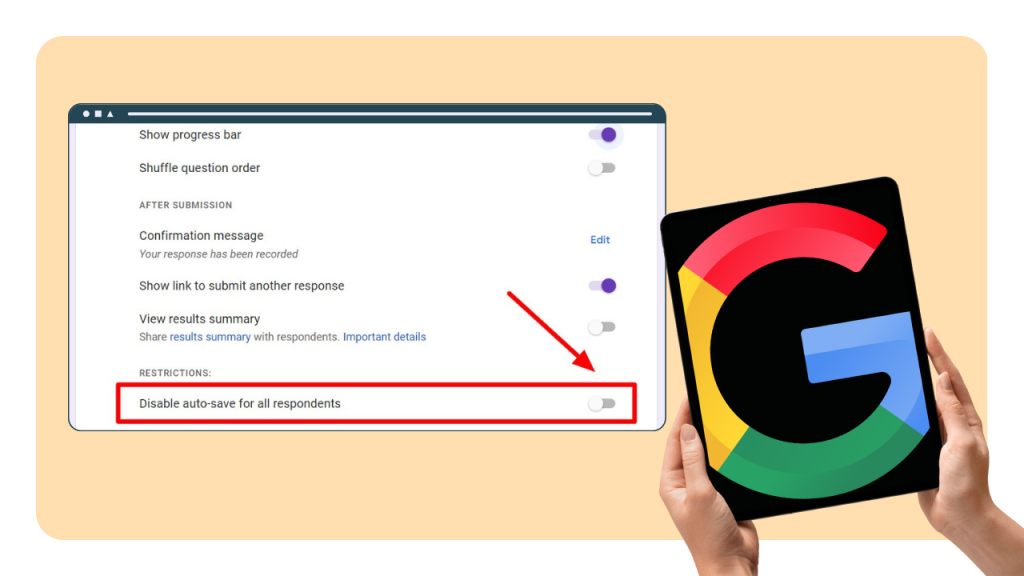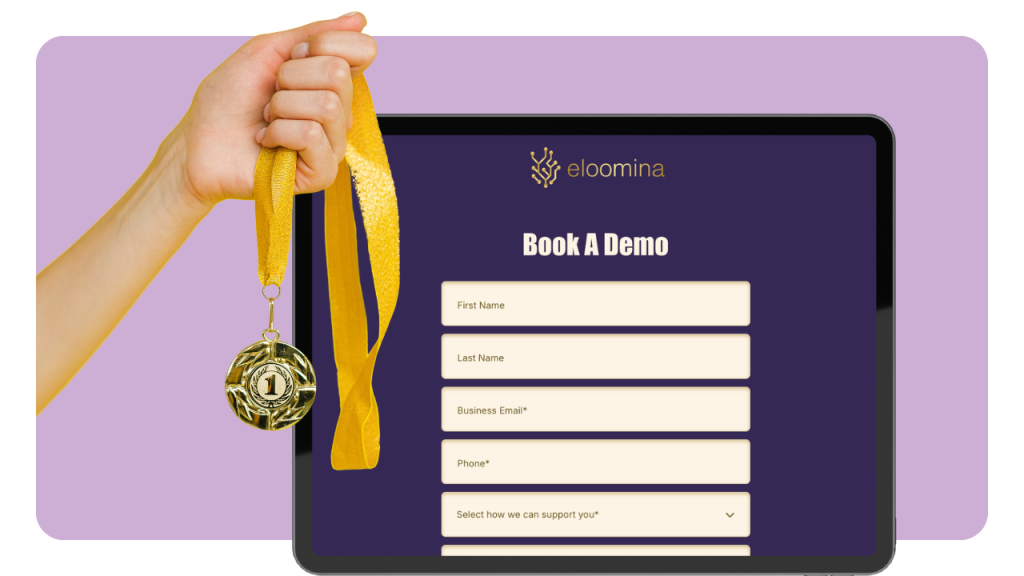If you’re getting plenty of traffic but weak conversions, your lead generation landing page is likely the missing link.
These pages turn anonymous clicks into qualified contacts by offering clear value with one focused CTA.
What You’ll Learn in This Guide:
What a lead generation landing page is and why it’s essential for conversions
The key elements every high-performing page needs
Best lead generation landing page examples, what’s working and what could be better
Proven best practices to design and optimize for higher sign-ups
How to create one quickly with involve.me
Quick optimization tips you can apply today for instant results
FAQs about lead generation landing pages
Final takeaways + free landing page templates
What Is a Lead Generation Landing Page?
A lead generation landing page is a focused web page designed to capture visitor information such as name, email, company, or job title in exchange for something valuable. Unlike a checkout or sales page, its primary goal isn’t to close a purchase, but to start the relationship by collecting qualified leads.
These pages usually offer an incentive that encourages visitors to share their details, such as:
A free trial or demo
A downloadable resource like a guide, checklist, or whitepaper
Access to a tool or calculator
A webinar registration or online event
A waitlist for an upcoming launch or course
A personalized price quote or consultation
What makes them powerful is their focus: one clear offer, one CTA, and zero distractions. By matching the message of the ad, email, or social post that drove traffic, a lead gen landing page ensures relevance and keeps the visitor’s attention on a single goal: conversion.
Why You Need Lead Generation Landing Pages
If your ad campaigns or social media efforts are driving traffic to a homepage, you’re missing out. A dedicated landing page provides:
Higher relevance and clarity tailored to the specific ad or campaign.
Better conversion rates: one offer, one action, no competing links.
Stronger alignment with long sales cycles especially valuable for B2B, SaaS, and service-based businesses where nurturing is key.
Actionable data capture every submission fuels segmentation, lead scoring, and ROI tracking.
Simply put, lead generation landing pages transform raw traffic into qualified contacts, setting the stage for nurturing prospects into paying customers.
Key Elements of High-Converting Lead Gen Pages
The best lead generation landing pages all share certain traits that keep visitors engaged and drive them to convert. Here’s what to focus on:
Single goal + single CTA: Eliminate distractions by removing menus and links. Every element should drive toward one clear action. (With involve.me, you can repeat the CTA across multiple steps without breaking focus.)
Benefit-led headline with crisp subhead: A strong headline promises value, while a short subhead clarifies the offer.
Visual clarity: Use product screenshots, explainer videos, or a bold hero image to show what visitors get. (involve.me templates allow you to embed visuals directly in multi-step flows.)
Right-sized form: Short forms reduce friction, while multi-step forms gather more data without overwhelming. (involve.me specializes in multi-step, conditional forms that feel natural and keep completion rates high.)
Trust signals: Add testimonials, recognizable client logos, star ratings, or even a simple privacy statement near the form.
Personalization: Conditional flows let you tailor questions and outcomes to each visitor. (This is where involve.me shines, guiding leads to personalized results while scoring them in real-time.)
Mobile-first layout and fast load speed: Since most visitors arrive on mobile, ensure your page loads quickly and adapts seamlessly.
Message match: Keep copy and visuals consistent with the ad, email, or post that drove traffic to the page.
Analytics & testing: A/B test headlines and CTAs, track funnel drop-offs, and use AI insights to refine performance. (involve.me provides built-in analytics and automated reports so you know exactly what’s working.)
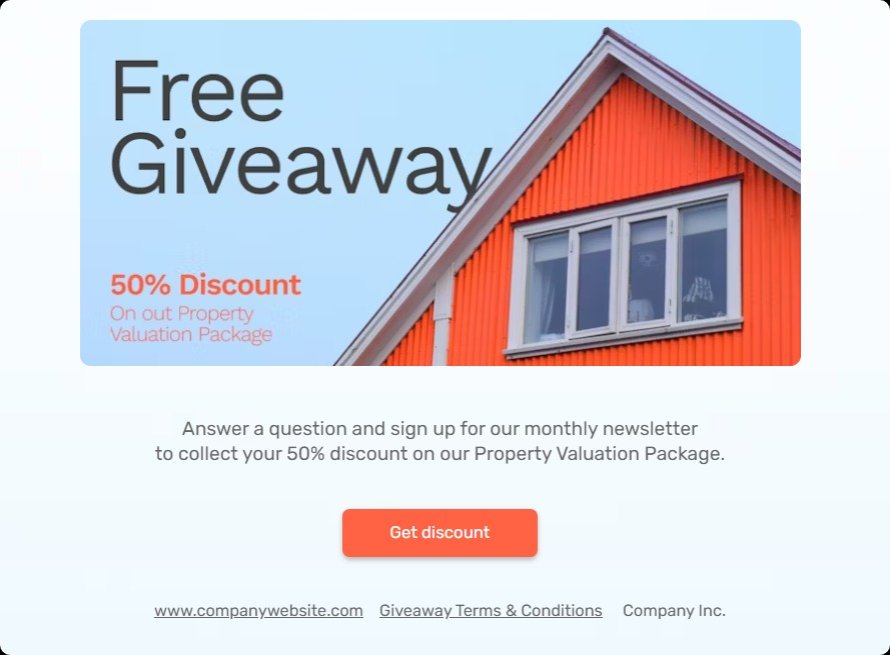
10 Best Lead Generation Landing Page Examples
Here is a list of some of the best landing page examples.
1) Demo Request (Mixpanel)
A demo landing page is a classic for SaaS and B2B companies. Mixpanel’s version works well because of its clean layout, repeated CTAs, and logos from trusted brands that build instant credibility. Product visuals help prospects know what they’re signing up for.
What’s Working: Clean layout, repeated CTAs, social proof logos, product visuals.
Copy This: Repeat the CTA in multiple sections and use benefit-driven bullets.
Improve: Add microcopy about privacy and explain what happens post-submission.
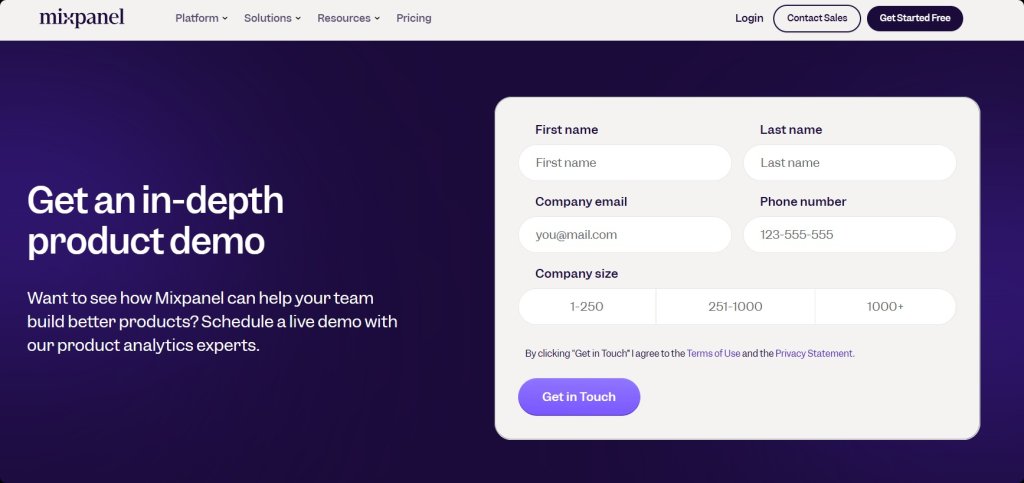
2) Whitepaper / Guide (e.g., Oracle)
Oracle uses a clear white paper landing page setup with a professional design, well-placed visuals, and a form to download the resource. It includes authoritative branding, makes it obvious what you get, and targets decision-makers.
What’s Working: The landing page shows an image of what you’ll download (the white paper) to set expectations. Also, bright, contrasting CTA (“Download this whitepaper now”) that stands out.
What to Copy: Make the CTA prominent and action-oriented.
Improve: Reduce the number of form fields if there are many; long forms discourage sign-ups.

3) Short Tool / Free Report (e.g., WordStream-style)
Free tools or reports convert well because they give immediate value. WordStream’s grader shows a preview of results, so visitors know exactly what they’ll get before entering an email. This mix of instant value plus gated insights makes people more likely to opt in.
What’s Working: Preview of value, short form, checklist of insights.
Copy This: Add a “See what you’ll get” preview module.
Improve: Include privacy notes and an FAQ under the CTA to address concerns.
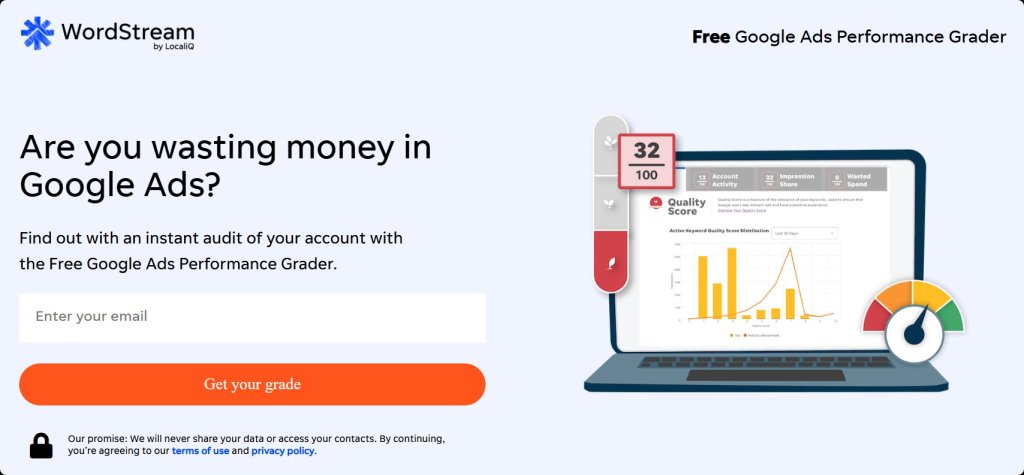
4) Webinar Registration (e.g., LocaliQ-style)
Webinar pages are effective when they’re simple and outcome-focused. LocaliQ’s example puts the topic, time, and speakers front and center. This clarity plus a short form ensures higher signups for the live or recorded session.
What’s Working: Clear details, outcome-led headline, short form.
Copy This: Add agenda bullets and a note about replay access.
Improve: Include one-click calendar adds and post-signup reminders.
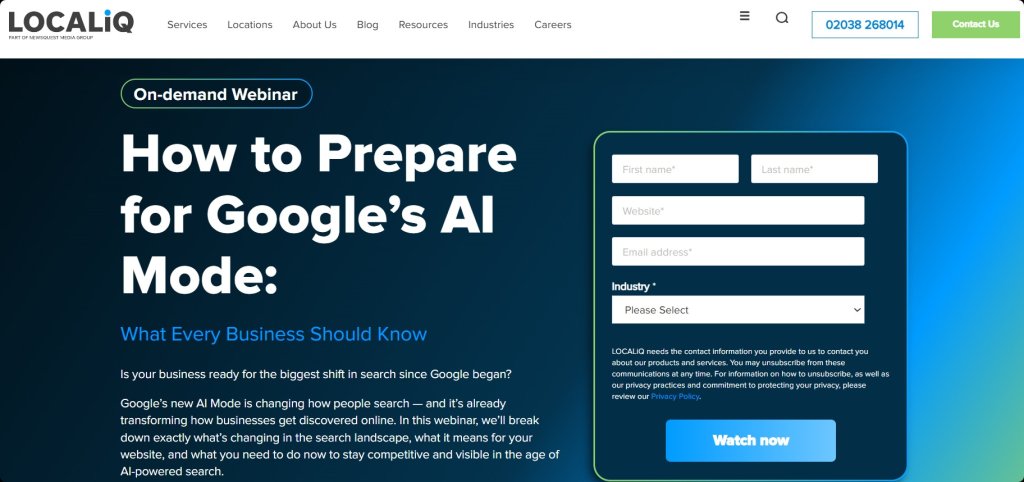
5) Waitlist / Launch (e.g., Marie Forleo-style)
When enrollment is closed, a waitlist page captures demand. Marie Forleo’s B-School page uses anticipation, testimonials, and scarcity to collect emails. This turns “not now” traffic into future customers.
What’s Working: Anticipation + scarcity, proof near form, simple opt-in.
Copy This: Use “Join the waitlist” clarity and highlight testimonials.
Improve: Add messaging about what happens next and launch timing.
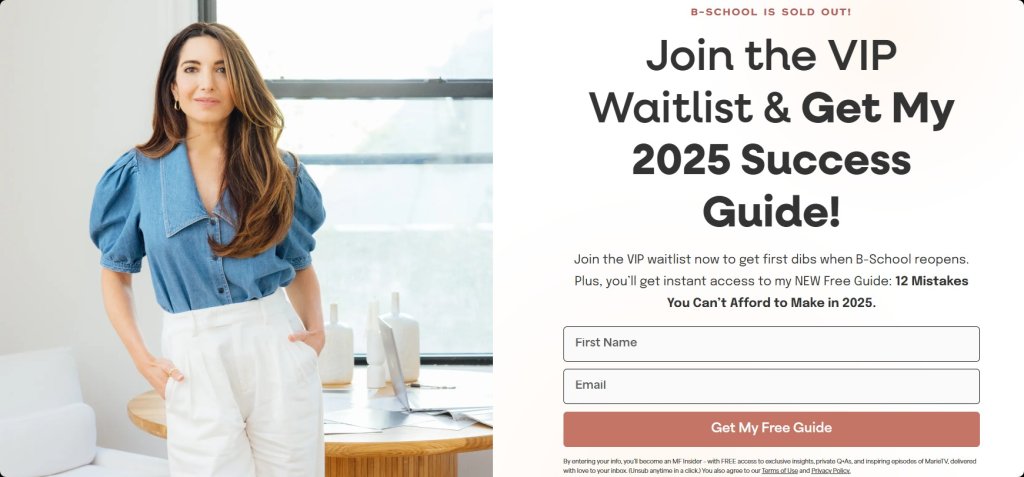
6) Product Tour / Qualification (e.g., BigCommerce-style)
Product tour pages filter for serious buyers by setting expectations and asking more detailed form questions. BigCommerce’s example balances clear “what you’ll learn” bullets with a form that qualifies leads before sales gets involved.
What’s Working: Agenda-style list, longer form for qualification.
Copy This: Add sticky CTAs and progressive form fields.
Improve: Clarify why fields are required and how data is used.
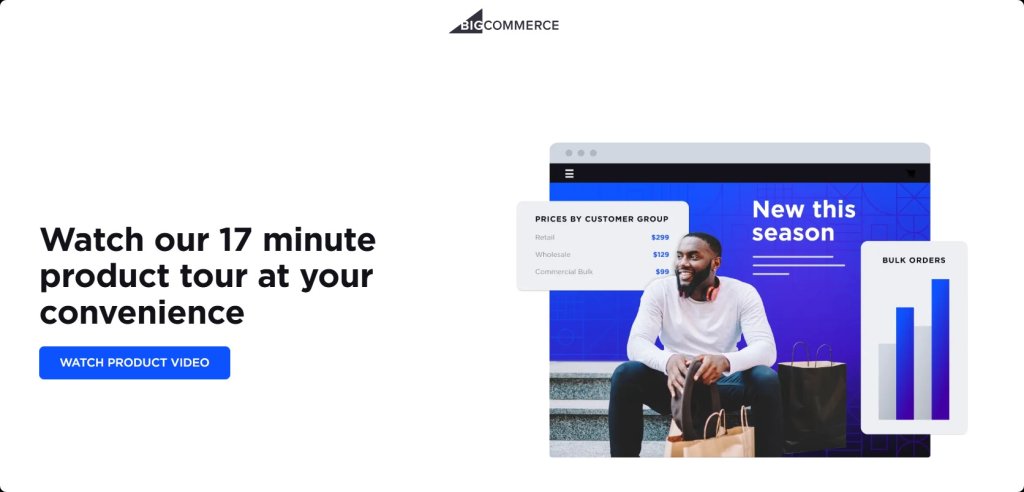
7) Giveaway / Contest (e.g., TripADeal Contest)
Giveaway pages generate quick lead volume with a strong incentive. The best examples showcase the prize, add urgency with a deadline, and keep the form short.
TripADeal ran a giveaway landing page with a headline promoting a US$13,000 travel prize. The page uses high-quality images of the destination, a clean entry form, and bullet points so visitors can quickly scan what they’ll win. It’s a strong example of urgency, prize appeal, and clarity.
What’s Working:
Bold, attention-grabbing headline (“Take flight with this US$13K giveaway”) that immediately communicates the prize.
Form placed above the fold, minimal fields, no distracting nav elements.
Copy This: Include a deadline or urgency (“Enter by X date”) to drive action. (If not present, add it.)
What to Improve: Add proof of past winners or testimonials to show legitimacy (people who won before).
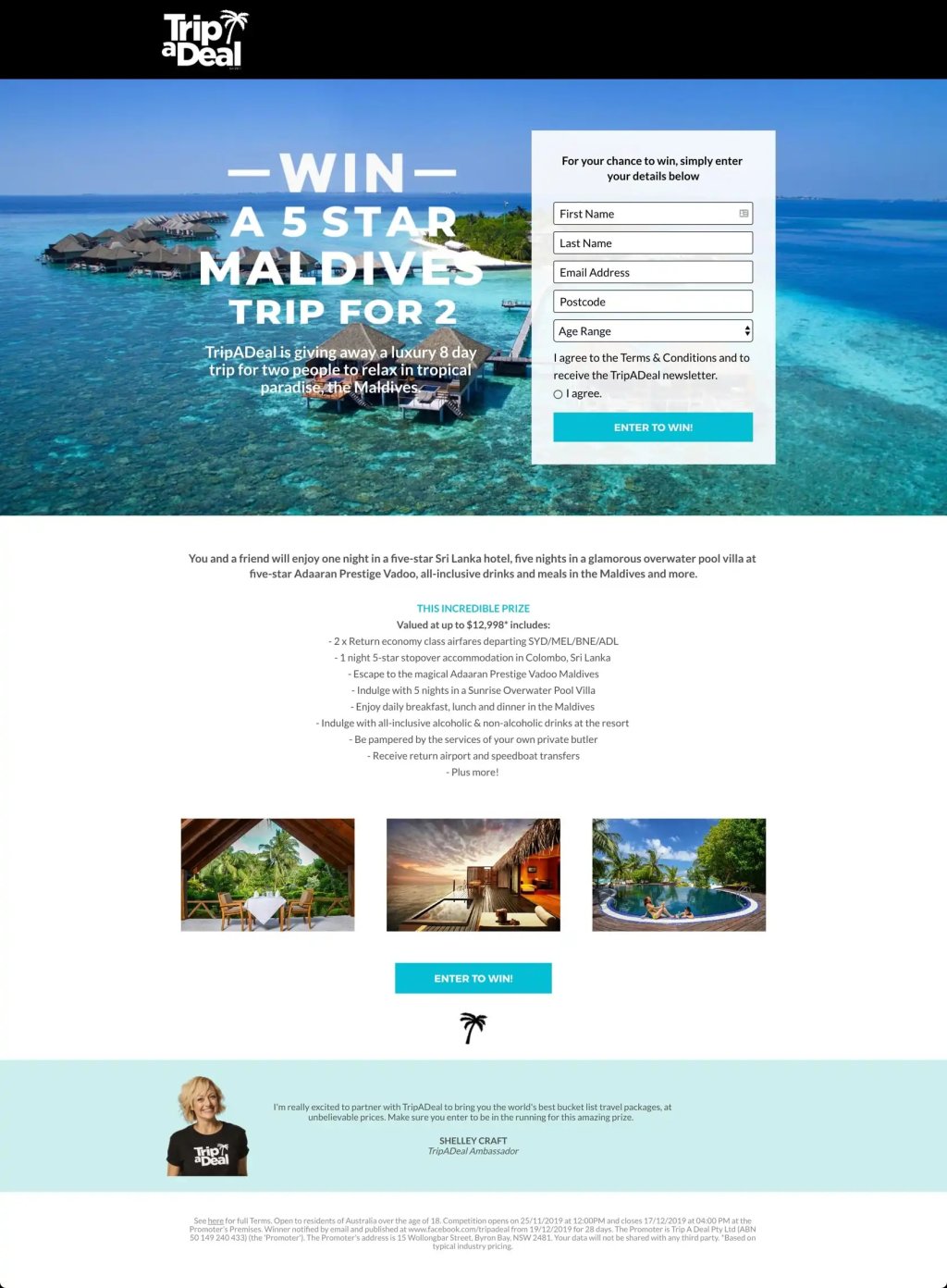
8) Course / Long-Form Sales (e.g., Freelance to Business Owner-style)
For high-ticket offers like courses or coaching, long-form pages convert because they build trust and address objections. This type of page layers stories, testimonials, and proof before asking for sign-up or purchase.
What’s Working: Story-driven copy, proof blocks, multiple CTAs at decision points.
Copy This: Add a summary at the top for scanners and FAQs near CTAs.
Improve: Keep CTA language consistent and action-oriented.
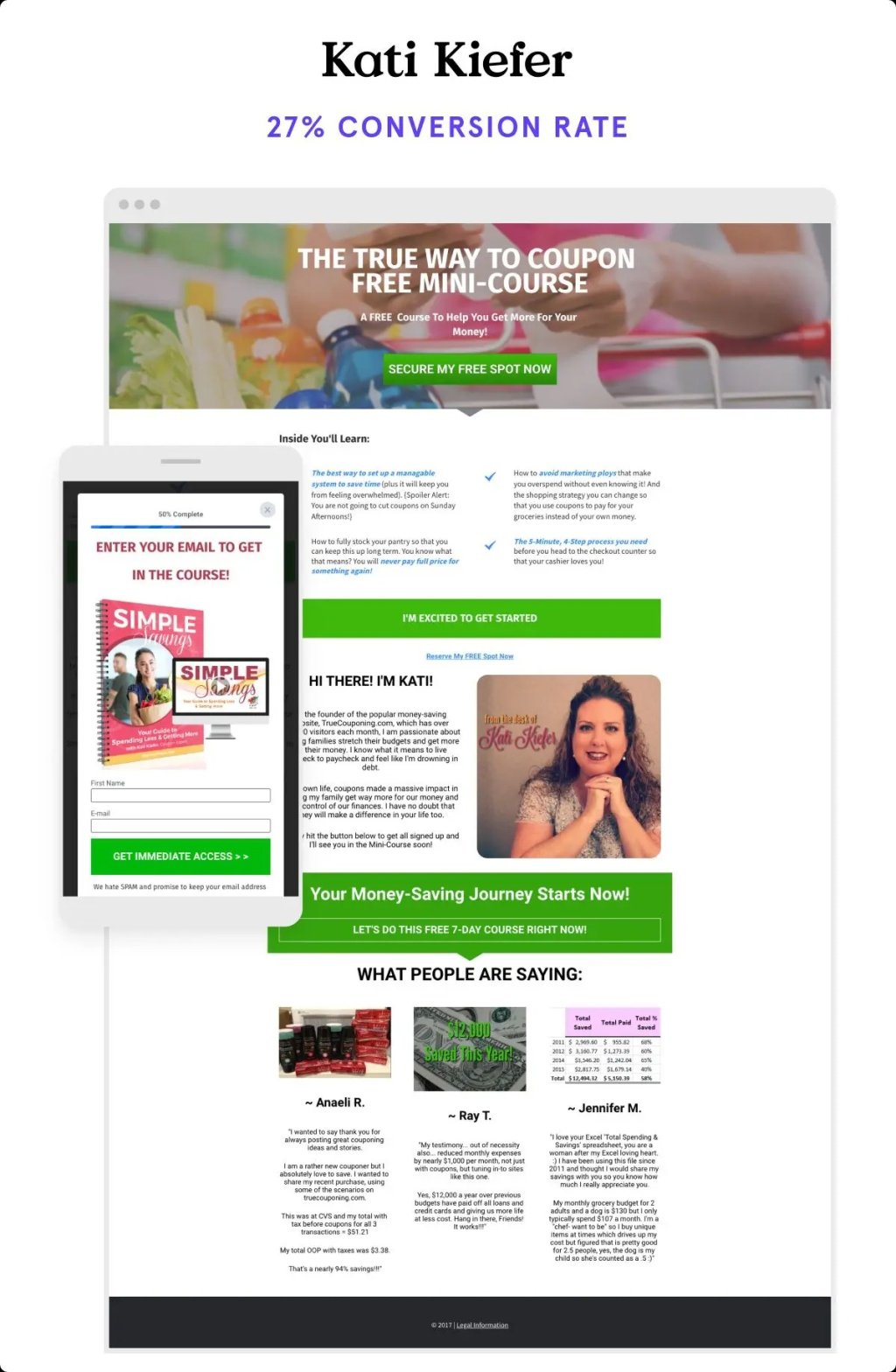
9) Free Trial SaaS Page (e.g., Trello / Asana-style)
Free trial pages work best when they reduce friction. Trello and Asana use simple forms, clean design, and clear benefit-driven headlines. By highlighting ease of use and trusted logos, they lower the barrier to signing up.
What’s Working: Minimal forms, strong headline, client logos.
Copy This: Use “It’s free” as a risk remover and show quick benefits.
Improve: Add a chatbot or optional qualification questions to capture more context.
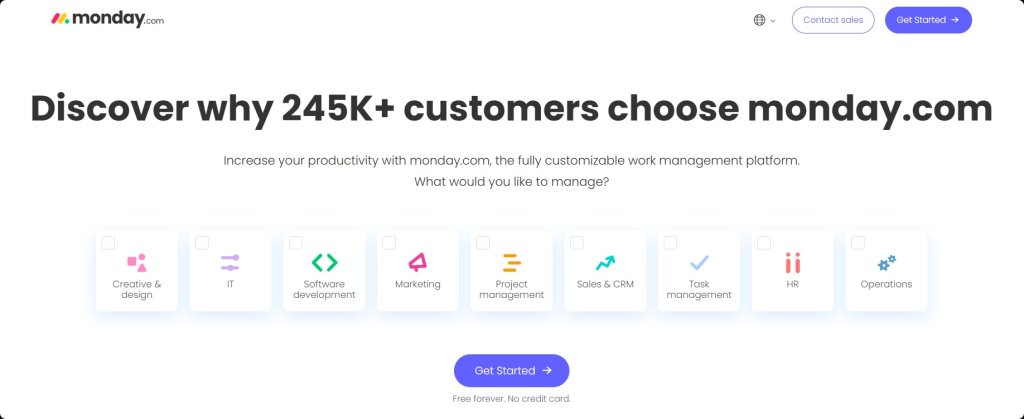
10) Ebook / Checklist Download Page
This type of page is a staple in B2B marketing. A strong headline, quick bullet list of what’s inside, and a clean form are enough to capture interest. Trust signals like testimonials or “X people downloaded this” can boost conversions further.
What’s Working: Benefit-led headline, concise bullet list, short form.
Copy This: Show a visual of the ebook cover or checklist template.
Improve: Replace generic CTA text with specific, benefit-driven copy like “Get My Free Guide.”

Lead Generation Landing Page Best Practices
A high-converting lead generation landing page doesn’t happen by chance, it’s the result of following proven best practices. Here’s what to keep in mind when designing yours:
Keep one goal + one CTA: Don’t overwhelm visitors with multiple asks. You can repeat the CTA throughout the page, but keep it consistent and focused on the same action.
Place the CTA above the fold: Ensure the primary call-to-action is visible without scrolling. Add sticky or repeated CTAs so visitors can act anytime.
Limit form fields: The shorter the form, the higher the conversions. For more data, use multi-step forms to qualify leads without creating friction.
Add privacy microcopy: A simple “We’ll never share your data” line with a link to your privacy policy builds trust and reduces form abandonment.
Match the message with ads/emails: Align headlines, visuals, and copy with the campaign that brought visitors to your page. Consistency boosts trust and conversions.
Use trust signals: Place testimonials, customer logos, or ratings close to the form. Highlight specific results (e.g., “Helped 2,000+ marketers double sign-ups”).
Design for mobile first: Optimize for small screens: compress images, avoid heavy scripts, and keep forms thumb-friendly.
Run A/B tests: Test headlines, CTA copy, form length, and hero visuals. Small tweaks can lead to big conversion lifts.
Track drop-offs: Monitor analytics to see where users exit. Reorder or remove fields in your flow if they cause friction.
How to Build a Lead Generation Landing Page (Step-by-Step Guide)
The fastest way to create a conversion ready lead generation landing page is to start with a framework that already does the heavy lifting. With involve.me, you don’t need to code or hire a designer, you can create your own landing pages within minutes.
Pick a template: Choose from proven formats like demo requests, webinar registrations, quote calculators, quizzes, or waitlists. Each template is pre-built for lead capture, so you only need to customize content and branding.
Create Your Own Lead Generation Landing Pages
Get Started with 350+ Templates
Appointment Funnel Template
Business Consultancy Appointment Template
Financial Advisor Appointment Form Template
Map the flow: Plan out your lead journey: start with qualifying questions, use conditional paths to segment visitors, and end with a tailored outcome screen (e.g., confirmation, resource download, or meeting link).
Design for clarity: Lead with a benefit-driven headline, add product visuals or screenshots for proof, and sprinkle in testimonials or logos to build trust. Keep distractions minimal, no menus, no extra links.
Form strategy: Start with a short form to reduce friction. If you need more info, use a multi-step form that feels lighter while still qualifying leads. Enable form validation to ensure data accuracy.
Integrations that matter: Connect directly to your CRM or email platform, pass UTM parameters and traffic source details, and tag/segment leads automatically. This ensures sales and marketing always have clean, usable data.
Launch & optimize: Go live quickly, then improve continuously. A/B test headlines and CTAs, review funnel analytics, and use involve.me’s AI insights to uncover drop-offs or bottlenecks. Iterate weekly instead of waiting months.
Optimization Ideas You Can Steal This Week
Change your CTA to an action verb (“Get my demo” or “See my quote” beats “Submit”).
Add a ‘what happens next’ line under the button (reduces anxiety).
Move one key proof element (testimonial, logo, or rating) above the fold.
Replace a long single form with a 2–3 step flow, progress indicators keep visitors moving.
Place an FAQ accordion right under the form/CTA to address objections without clutter.
Add a content upgrade (like a checklist or worksheet) as an extra incentive for fence-sitters.
Final Thoughts
A lead generation landing page can make the difference between visitors who bounce and visitors who convert into qualified leads. From free trials and webinars to contests and product tours, the best pages share common traits: clarity, focus, trust signals, and a single clear goal.
The examples above show that whether you’re a SaaS brand, a course creator, or an ecommerce business, the right structure can multiply your conversions. But building high-performing landing pages doesn’t have to be complicated or expensive.
With involve.me, you can launch personalized, multi-step landing pages that not only capture leads but also qualify, score, and route them automatically. Templates for demos, calculators, waitlists, and more give you a head start, while AI analytics and integrations help you optimize every week.
Ready to build your own high-converting lead generation landing page?
Start free with involve.me today
Create a landing page in minutes
No coding, no hassle, just better conversions.
FAQs About Lead Generation Landing Pages
-
Absolutely. Even a single line like “We’ll never share your data” boosts trust and reduces abandonment.
-
Only as long as it needs to be to persuade someone to act. No magic word count.
For a simple offer or motivated visitors, a short page can win: Hero, a few bullets, clear CTA. For complex, high-stakes, or trust-heavy offer? Go longer. Add proof, details, FAQs, and objections handled. The rule: clarity and sufficiency. Include what your audience needs to feel confident, and trim the rest. Put essentials up top. People who need more will scroll. People who are ready will click. A practical starting point is a medium-length page with a handful of tight sections, then test from there. The lesson? Context matters. -
Start with the headline and CTA, they have the biggest impact. Then move on to form length, hero visuals, and proof placement.
-
Across industries, 5–15% is common, but top performers hit 20–30% with optimized flows.

